washingtonpost.com's view
SHANGHAI It was an incidental weekend, the kind in which everything is possible, but nothing works out the way you imagined.
I was back in the States after a week abroad, eager to spend time with my wife, Mary Anne, before coming here for another week away.
I arrived at Washington Dulles Airport where Ria Manglapus, my associate in vehicle evaluations, picked me up in the 2008 Volvo C30 T5 2.0 hatchback. I was surprised.
The shock wasn’t that Ria picked me up. She loves driving and will find any excuse to get behind the wheel, a predilection that makes her the taxi driver of choice for family and friends.
The surprise was the Volvo C30, the smallest Volvo automobile, which also is sold in this Chinese city of 20 million souls.
I expected Ria to fetch me in the 2008 Mercedes-Benz C300 Sport, a car we both had driven, liked and written about. Why was Mercedes-Benz sending it to us again? I assumed the company had made a running change — a technical adjustment during current production — it thought journalists should check out.
I was prepared to be bored — until Ria pulled up in the “brilliant blue pearl” Volvo C30, one of the cutest hatchbacks I’d ever seen.
“You don’t have much time to drive this one,” Ria said. “You’d better take it.”
I complied; and for the first time, I was happy to have committed the common male error of hearing a woman say one thing — “C300” — when she clearly said another — “C30.”
It was love at first contact with the driver’s seat, an affection largely stemming from the C30’s retro styling cues, such as its glass rear liftgate, lifted from the Volvo 1800ES of the early 1970s. I loved that car, which looked different from anything on U.S. roads back then. It was the perfect comrade-mobile, a four-wheeled magnet for hip, young idealists out to change the world . . . after the next all-night rap session that, like the last, ends with an all-day party.
But retro styling alone does not make an attractive car. There is the matter of interpretation, of how classic styling cues are given currency, made relevant to the time at hand. The 2008 C30 does this exceptionally well, especially in the interior, which is highlighted by the most elegantly simple and beautiful instrument panel and central console ever installed in a car.
The super-slender console flows from the dashboard to the floor in the manner of a waterfall. There is as much art to it as there is substance.
That simplicity carries over to the C30’s four anatomically designed seats. They fit backs, butts and torsos perfectly. Their anti-whiplash headrests support necks and heads without making occupants feel as if they’ve been strapped to restraining tables.
Standard Kalix T-Tec material, the used in wet suits and rugged outdoor clothing, covers the seats. It is practical, comfortable and durable. It obviates the need for leather seat covering, although leather is an option in the C30.
Overall, the little front-wheel-drive car, available with a standard six-speed manual transmission or an optional five-speed automatic, just feels right, especially in tight city traffic where it is wonderfully maneuverable.
We recommend purchase of the six-speed manual, even for people who have not driven manual transmission cars, or for those who have driven manuals and found them intimidating, because there is nothing the least bit intimidating about the manual gearbox in the C30. It is fluid, intuitive, and easy. There is something wonderfully sensuous about the way it moves. But you’ve got to feel it to believe it.
I could go on. But this is turning into a rave — justifiably. The C30, with a turbocharged, 227-horsepower five-cylinder engine and an independent four-wheel suspension, is one of the best driving experiences available under $25,000.
I am happy that Ria managed to hold onto it until I returned from the last trip. Here’s hoping she finds a way to wrangle the automatic version from Volvo — just, hmm, for purposes of comparison — and hold onto it until I return from this one.
Latest news



